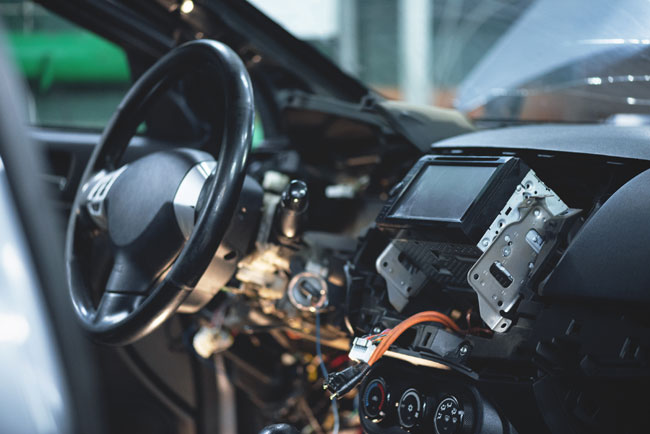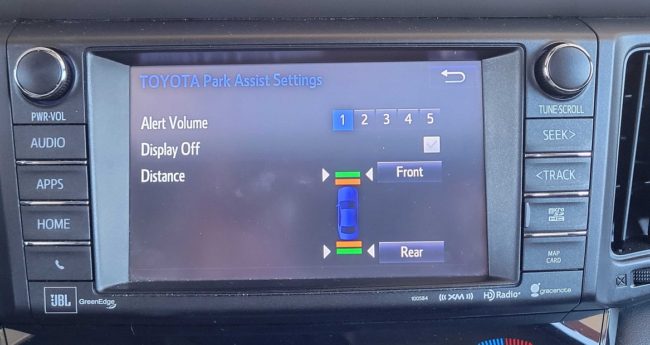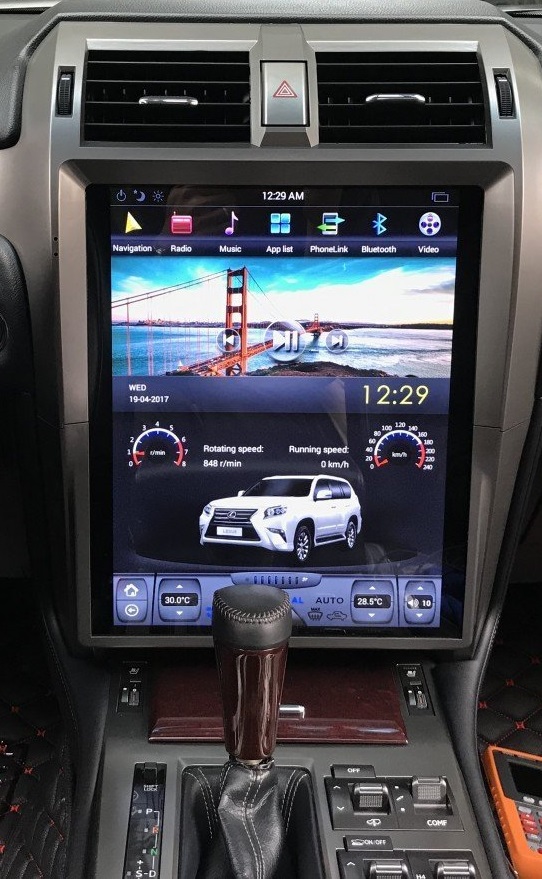
Why do people replace factory radios ?
The average age of passenger vehicles in US is climbing. It sits at 11.9 years in 2020 and is poised to grow considering the fear of public transportation and work from home reality of today (it decreases the car usage).
The most outdated part in the vehicle after only few years is it’s factory installed radio. This is mostly due to technology evolving faster and allowing for more new functionality comparing to the rest of the vehicle.
Technology is not the most important component in the car to provide a pure transportation needs from point A to B. The car will still operate and drive regardless if factory radio is functioning. Compare that to any other component like wheels, windshield, engine and so on. However technology in the vehicle leads to much more enjoyable commute, more satisfaction and safer driving in general if implemented properly. If poorly used, it can bring distraction and frustration, leading to incidents and crashes.
The biggest piece of technology in a vehicle remains its radio, the heart of infotainment, convenience and communication on the road. Radio is designed to interact with majority of 50-100 processors that control a different parts of the modern vehicle and provide a manageable set of information the driver can access and use.
Automakers spending thousands of man hours to perfect the location, functionality and UI of the radios. Meticulously working on things from hard buttons location, size of the controls, way to use it a moving vehicle, to a visual design of the radio that matches the interior aesthetically and illumination wise.
Regardless the efforts, if stereo fails to satisfy the customer in most expected technological aspects, it will becomes a frustration point and get replaced eventually.
As technology penetrates deeply into the car, the radio becomes more integrated, more seamless and fluid in functionality, many people greatly underestimate the complexity of replacement procedure or even immediate outcome of this presumably simple operation. Below we will analyze some unexpected consequences people do not realize exist when replacing the factory radio.
Factory XM radio will be lost
There is no generic way to keep factory XM tuner since on most modern vehicles it is built in to the OEM stereo. If XM functionality is required, make sure to select the aftermarket radio with an interface that is compatible with XM tuners such as SXV300. Even low end radios (MVH-AV251BT,XAV-AX5000) offer that ability. You will need a separate SAT capable tuner for this kind of install and will need to install an aftermarket XM antenna. In some cases you can find an OEM antenna retention adapter that converts to SMB connector used on SXV300 tuner.
AM/FM reception will suffer
In modern vehicles, there are plenty of antennas around the vehicle to provide the best signal reception the vehicle can provide. Roof top mounted shark fin antennas, transparent windshield or side mounted antennas are designed with respect to vehicle’s shape and maximize the reception in any situation. Most factory radios have at least 2 antenna ports for better radio signal fusion.
More advanced stereos may feature 3-4 antenna inputs, antennas with built in amplifiers or special antenna module connected via UTP/MOST. These kind of stereos usually provide the best in class AM/FM/DAB/HD Radio reception available for the particular vehicle. By replacing the radio with even the best aftermarket stereo the quality of reception and functionality will degrade.
Some considerations to minimize the impact on AM/FM reception
If your OEM radio has passive antenna(s)
Choose the best quality antenna adapter that match your car make/year standard. The quality of materials and impedance is very important as AM/FM signals are high frequency and weak by nature. Most aftermarket radios use Motorola style plug for antenna and 75 Ohm impedance. Automakers follow their own standards that are even different from year to year. Check the impedance directly on the radio or stereo sticker.

If your OEM radio uses active antenna(s)
Make sure the antenna amplifier is getting power via specific adapter for the vehicle (40-EU55 for example). Without that power the antenna will still work but the quality of the signal will be inferior.
If your OEM radio uses special antenna module connected via UTP or MOST
As seen on some European vehicles (Volvo, AUDI etc) there is no generic solution for such situations. You will need to install a standalone aftermarket antenna.
Backup camera needs retrofit
In all vehicles 2016+ backup camera is mandatory by law and it is very essential in providing safety. There are many ways to keep the backup camera functional but you will need a special wiring to tap into gear selector or CAN bus and convert OEM analog camera to aftermarket input. In case if your configuration has a digital backup camera, there is no generic way to keep it, camera has to be fully replaced. Checking what camera you have with professionals is recommended to avoid sticker shock.
360 view, side cameras will be lost
360 or side view cameras are expensive option that most likely will be lost when installing the aftermarket stereo. There is no generic way to connect these cameras into an aftermarket radio. 360 aftermarket camera installation will be quite expensive due to complicated wiring, mounting and calibration process. OEM front camera in some cases may be converted with a specially wired interfaces (speed or button based).
Parking sensors may still work but control will be lost
On vehicles with parking sensors, there is no standard interface to capture that data and project it to the aftermarket radio. Some vehicles have an ability to show sensor information on a dashboard gauge cluster area. If your vehicle does show parking sensors on its factory screen only, then you will lose that after installing an aftermarket headunit. To regain the functionality the best way is to make sure your new radio supports an aftermarket sensor module (ND-PS1 for example) and you will need to replace the factory sensors with compatible ones. The whole job is quite costly due to extensive wiring, retrofitting and calibration needed. If your main gauge cluster display shows sensor information, you may still keep the sensors functionality, but most likely any controls of the sensors will be lost. Things like alert volume, sensitivity and so on has be set from the factory radio before removing it. And these settings will be reset after the battery replacement or lost of power in the vehicle.

Instrument cluster and HUD integration will be lost
In most modern vehicles, there is a lot of information that is duplicated on gauge/instrument cluster or HUD in front of the driver. Some information comes directly from the OEM stereo. Things like current audio mode, media information and some vehicle maintenance information. There is no generic way to regain that integration back.
Online features will be lost
In many vehicles, online OEM connectivity is not highly visible or even claimed publicly. There are 3 major ways the vehicle can access the information online:
- Sirius XM broadcasts (US/Canada)
Sirius XM subscription allow some OEM stereos to capture weather, traffic, fuel prices directly into OEM radio. Some aftermarket radios are capable of doing the same via add-on tuner. - HD radio (US/Canada)
In some locations, there is a broadcast information ( weather, traffic, fuel prices) available via HD Radio digital feed. Some OEM radios support that ability and use extra antenna port for that. This functionality is not readily available in aftermarket radios. - Factory 2G/3G connectivity
On some modern vehicles 2G/3G connectivity is present for many reasons: firmware updates, recall messages, maintenance schedule, traffic data, remote start, track covers and so on. In some cases these services are included into the cost of the vehicle and directly work with the factory radio. There is no way to get that connectivity back after installing an aftermarket headunit.
AC controls glitches (Tesla style aftermarket)
It might be tempting to install a huge vertical style display in the vehicle aka “Tesla Style” radios. They look great on pictures and do provide a similar wow effect as an original Tesla headunit. For that kind of installation you will need to dedicate the whole dash for the radio, giving up the hard buttons for many functions such as AC controls, volume buttons, knobs for tuning the stations or scrolling and so on. 
The biggest drawback of replacing the hard buttons with soft UI based buttons is reliability. In case of software glitch in “Tesla Style” radio, your vehicle may misbehave and you will be left without a working AC in 100F+ heat or freezing cold during the winter. We saw reports that in some cases such radios or the way they installed may lead to damaged AC, ECU controllers in the vehicle. Which may render the whole car useless. The cost of repair may be extremely high.
Factory amplifiers, subwoofers, speakers may be lost
The vehicle is a most common place for people to enjoy some tunes. Usually people prefer nice and clean audio from their speakers. The quality audio output comes from the fusion of all components involved: headunit, amplifier, subwoofer, wiring and speakers. To sound good, all these components should be compatible with each other and communicate in the same “language”. Most car manufacturers highly optimize their vehicles for quality sound. They customize all the components to fit and sound properly in a particular vehicle. By replacing the stereo with aftermarket, it might be impossible to regain the same audio quality. In many cases the custom made interfaces will be required to even allow factory amplifiers to work properly with an aftermarket radio (such as TYTO-01).
Each branded audio system such as JBL, 7Logic, Bose, Mark Levinson etc are using proprietary protocols not supported by aftermarket manufacturers. Even if it is possible to enable factory amplifier to work, there still be issues related to the audio input/output levels and input/output impedance of the aftermarket stereo vs amplifier or speakers. The easiest way to make sure the audio system sounds right is to totally rework the whole audio system by installing an aftermarket amp/sub and speakers by the car audio professionals. Even though it may improve the audio quality significantly, the cost of that operation is prohibitive for an average user.
Visual aesthetics will suffer
Modern vehicles are not the same as they were 20 years ago with standardized dash designs and radio looks. Modern trends require vehicle manufactures to come up with innovative and great looking designs to win customers. These designs require custom made materials, lighting, textures and shapes. By incorporating a single or double DIN stereo you will see this as a downgrade. Add to that the way the stereo will be blended into the interior. Not matching dash panels, different texture and aftermarket stereo backlit colors that will be hard to match with the rest of the vehicle. There are some aftermarket stereos that are made for the specific vehicle, but usually it is from unknown brands with questionable reliability.
Resale value will decline
As much as you love your vehicle, you won’t keep it forever. Selling the vehicle with an aftermarket install is a much harder proposition than stock. For most buyers of used vehicles the more retrofitting were done to the vehicle, the less value the vehicle has. Replacing any part of the vehicle with aftermarket is tricky and depends on many factors. Replacing the radio is no exception. Cutting the wrong wire or slicing the wrong connector, you will trigger unwanted consequences in the vehicle or can even damage the ECUs at any moment. There is no generic way to make sure the aftermarket radio installation was performed properly and professionally. And who exactly did that for the vehicle you’re trying to buy.
Hidden cost breakdown
- Optional XM Tuner+ interface: $70+ $100
- AM/FM antenna converters: $20-$40
- Steering wheel retrofit: module $50+ install $80-$100
- Backup/front camera module and wiring: $100-$400
- 360 camera, side camera: $400-$1000
- Parking sensors and module: $100-$200. Installation >$500
- Online features: $10-$15 month
- Factory amplifier integration: $100
- If OEM amplifier integration not possible, replacing it: $300-$1000
- If factory speakers not compatible with new amp: $100-$1000
- DIN dash kits, custom fitting: $100-$500
Alternatives from GROM Audio
In many situations it is possible to add features you want from the infotainment system without changing the factory radio. GROM Audio offers unique way to modernize the stereo without breaking the bank or risking the warranty. Adding CarPlay, Android auto, DVR, cameras and any app directly to your factory stereo:
https://gromaudio.com/store/vline/index.html
